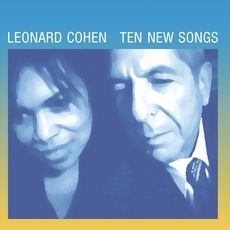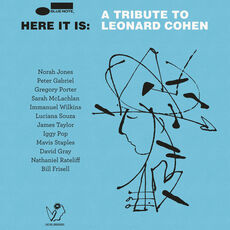Suzanne, 1967
Because it was the first. The first song from Leonard Cohen’s first album. And for some, the first time they’d heard the Canadian singer, often on an old vinyl whose crackling sounds seemed to be part of the music. And it’s even better without the crackling. Folk singer Judy Collins had recorded “Suzanne” the year prior, but it was the writer’s version that we all eternally fell in love from our very first listen. It’s the stylistic template that Cohen would more or less stick to until the very end: a few repeating guitar arpeggios, female choirs, a soft draping of chords, and that voice, always elegant within its deepest disenchantment - his unique way of nurturing melancholy to the point of becoming addicted to it. With “Suzanne” in mind, the entirety of the album Songs of Leonard Cohen sounds as if it were from another time. Its only equal in strangeness might be The Velvet Underground’s first album, released in the spring of the same year. Neither achieved widespread success upon their release, but they did indeed make history.
Leonard COHEN Suzanne
Rakam EmbertThe Partisan, 1969
On Cohen’s second album, Songs from a Room, “The Partisan” is the only track that features the female choirs that captivated us on the first, singing three couplets in French. This song wasn’t composed by Leonard Cohen: it’s an adaptation of a French Resistance hymn from World War II, written by Anna Marly in 1943 (“La Complainte du Partisan,” recorded to vinyl in 1963). Cohen, who had been written off as a mere beatnik singer, dives in as if he’d been at war himself. In this version, recorded in Nashville, but far from the conventions of country music, Leonard Cohen evokes the hypnotic soundtrack to a chilling black-and-white film.
Famous Blue Raincoat, 1971
Appearing on the album Songs of Love and Hate, “Famous Blue Raincoat” is perhaps his best song, since Cohen was first and foremost a poet, a singing writer, and this literary, poetic song opens up the listener’s imagination. The female choirs are hardly noticeable, as if trying not to wake anyone. The guitar arpeggio is also there, but slower, more spaced-out. It’s because it’s four in the morning, at the end of December, as Leonard Cohen says within this song, written like a letter, and signed with “Sincerely, L. Cohen.” The text is cryptic, but its interpretation is so delicate and embodied that each and every listener receives the letter to their home address. It’s the Canadian’s genius: he dives deep, all while keeping a sort of distance, an elegant coldness. It’s worth mentioning that the same year, 1971, Dolly Parton would come out with her future classic “Coat of Many Colors,” another masterpiece of narrative song. A big year for songs about coats.
Chelsea Hotel #2, 1974
At the Chelsea Hotel, she occupied room 411, and he, room 424. One spring day in 1968, they met in the elevator. Then in bed. Affair over. Three years later, she would die of a heroin overdose and he would write the first verses of a song in her memory. The song was composed on a plane between the United States and Ireland. Her name was Janis Joplin. It wasn’t mentioned in the lyrics, but the composer mentioned it to the press in 1976, regretting doing so immediately. With or without this unveiled part of its history, “Chelsea Hotel #2”, taken from the album New Skin for the Old Ceremony, is one of Leonard Cohen’s most simple, beautiful, and fragile songs, sounding as if it had been recorded the morning after the night of love, when she’s gone, and he is reunited with the real love of his life: solitude.
Don’t Go Home with Your Hard-On, 1977
In 1977, one would imagine such a song title to be in the repertoire of a punk rock group rather than that of Leonard Cohen. Perhaps tired of the grim, gloomy image that had stuck with the singer for ten years, he seems to make fun of himself on this album, entitled Death of a Ladies’ Man and produced by the hitmaker Phil Spector. Even the record sleeve declares a change: sitting with a cocktail and aside two beautiful women, Leonard Cohen hints at a smile. The party’s in full swing with “Don’t Go Home with Your Hard-On,” which Cohen sings in a boozy voice, accompanied by Bob Dylan and Allen Ginsberg on the chorus. It’s his discography’s most festive song, ending the night R’n’B style. It’s also worth noting that in 2013, the American rocker and producer Greg Ashley covered the album Death of a Ladies’ Man in its entirety.
Hallelujah, 1985
“We know you’re great, but we don’t know if you’re any good”: this now-legendary phrase was what the head of Leonard Cohen’s recording company declared when Cohen had him listen to “Hallelujah,” from the album Various Positions. Cohen was then thanked by Columbia after 18 years of loyal service, walking away with a rather shaky album (he would then enter into a period of synthetic productions) containing a ticking time bomb of a song, which proved excruciating to compose: “I filled two notebooks, and I remember being in the Royalston Hotel [in New York], on the carpet in my underwear, banging my head on the floor saying, ‘I can’t finish this song,” the writer explained. The album Various Positions wasn’t a wild success, but “Hallelujah” caught the attention of certain colleagues: Bob Dylan sang it on stage in the 80s, John Cale covered it in 1990, and Jeff Buckley made a transcendent version four years later on the album Grace. In the 2000s, “Hallelujah” even made its way into American TV series, the movie Shrek, and onto televised singing competitions, allowing Alexandra Burke to win X Factor. Forty years after its original version, “Hallelujah,” covered hundreds of times, has become a worldwide pop hit and its author took its success right to the bank, allowing him to go back on tour after a fifteen-year hiatus.
Leonard Cohen - Hallelujah (Live In London)
LeonardCohenVEVOEverybody Knows, 1988
The habit doesn’t make the monk, Leonard Cohen seems to suggest with his 1988 album I’m Your Man. The music is in line with the times, synthetic and sometimes even electro-pop, yet in half of the songs in I’m Your Man Cohen croons as if he’d recorded them twenty years earlier, such as “First We Take Manhattan,” “I’m Your Man,” “Tower of Songs,” and “Everybody Knows”: new future classics by Leonard Cohen which would be even better in concert in the 2010s than their 80s album versions. Leonard Cohen would never be the Pet Shop Boys, but rather the tremendous singer-songwriter he had always been, with songs dressed up in the style of the day. In “Everybody Knows” (composed by his backing vocalist Sharon Robinson), you find Cohen’s habitual dark side, but also a touch of “What’s the use?”, a casual fatalism. A bit like the record sleeve: a picture of Leonard eating a banana in a suit jacket.
In My Secret Life, 2001
The habit doesn’t make the monk, Leonard Cohen might have said, especially after having spent several years in a Buddhist monastery in California, then returning to lay life and recording the album Ten New Songs in his home studio. Now an ordained monk, had Cohen become wiser? Either way, the album, which opens with “In My Secret Life” finds a sort of elegant balance. Leonard Cohen is still in his synthetic phase, nearly approaching its peak. Cozying up with Sharon Robinson who co-wrote the lyrics, “In My Secret Life” is a sensual, numbing, and hypnotic song that you’d dream of listening to in the front seat of a fancy car parked by the sea at sunrise, anticipating the next song, “A Thousand Kisses Deep,” which is just as good.
Show Me the Place, 2012
Back in the saddle thanks to the success of “Hallelujah” and his international tours, Leonard Cohen kicked off the sixth decade of his career with the album Old Ideas. Its title is accurate and it was a good idea too. Cohen relegated the cheap synths to the background and returned to the acoustic instrumentation of the 60s and 70s. And the female choirs. And sometimes the piano - like on the sweet elegy “Show Me the Place,” which flows gently between piano, violin, organ, and choirs. Leonard Cohen nearly sounds like his disciples (Tom Waits, Nick Cave). His voice is that of a man who is no longer in the vigor of his youth. Coloured by the patina of fatigue, it becomes even more severe, fragile, and imposing; like an old book whose pages you have to turn with care. In a few years, he’d be destined to come to an end like Johnny Cash did, coming out with three solid albums every other year, in which he returns to his roots.
You Want It Darker, 2016
The last album Leonard Cohen recorded during his lifetime (there has since been one released posthumously), You Want It Darker announces its colour: dark. The song that opens the album and gives it its title is one of the most poignant of his half-a-century-long career. He starts off with disembodied, ghostly male vocals from the chorus of Montreal’s Shaar Hashomayim Synagogue, which Cohen frequented. A subdued baseline seems to move forward like a procession of prisoners. “I’m ready, my lord,” says the refrain. Cohen’s voice speaks more than it sings, as if he no longer had the strength to do anything, ready to make his grand departure. In the summer of 2016, the Canadian made public a letter written to the dying Marianne Ihlen, the one who had inspired “So Long, Marianne” fifty years earlier. In it, he tells her: “I will follow you very soon,” before dying on November 7, 2016, six weeks after the release of You Want It Darker.














